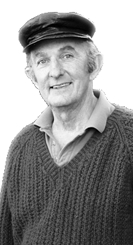This Place Where We Find Ourselves...
CFGV CommunitySpeaker, George Sibley
2013 Donor Reception Event

As the speaker at the 2013 Donor Reception Event, George Sibley graciously comments, “This is the evening every year when we gather as participants in the Community Foundation of the Gunnison Valley, to celebrate the donors who make the Community Foundation possible. Since most of us here are some of those donors, in one way or another, we could say we’re here to celebrate ourselves, but not as ourselves; we’re here to celebrate being part of something larger than the sum of ourselves.
Pam asked me to say a few words tonight about “sense of place,” a phrase that we hear a lot these years – a lot of the time by people trying to sell us something. But it is an important concept for a Community Foundation. We are not an organization focused around a specific important mission like homeless children or animals or improved trails or housing; instead the Community Foundation is concerned with all of those specific missions – but primarily as they each contribute to the life of this special place where we find ourselves now.
“This place where we find ourselves”: roll that phrase around in your mind for a moment. Wendell Berry, who has had a lot to say about sense of place, said, “If you don’t know where you are, you don’t know who you are.” I came here in my mid-20s half a century ago with no idea who or what I was, and only vague notions about what I wanted to be when I grew up, and it was here in the mountain valleys that I began to find myself in the middle of a small but dynamic and diversified community of young over-educated but under-experienced people like myself, mixing with a guardedly welcoming bunch of old-timers who taught me my first courses in community building and maintenance, and also taught me how to dance – two lessons not too unrelated. Many, maybe most of you came here with a better sense of who you are or were than that, but I think we all “find something of ourselves here” that is related to being here as opposed to being where we came from (because really, almost all of us did come from somewhere else). And maintaining the capacity of the Gunnison Valley to keep doing that for people may be the most important thing a Community Foundation can try to do.
So back to the original question: what is “sense of place”? And how do we develop a sense of place for here, so we can always be measuring what we do, by how well the things we do, nurture and sustain the place where we find ourselves?
Sometimes starting out by looking at extreme examples helps in defining something. I just finished reading a new book by Craig Childs who sets a “sense of place” extreme at one end of a spectrum. He’s a writer who lives over the hill in Crawford, in the Smith Fork of the Gunnison, when he isn’t out roving the world looking at other places. Childs has made a career out of writing very evocatively about his sense of the places he has visited. In his new book, called Apocalyptic Planet, he gives detailed descriptions of nine places that are all basically impossible for life as we know it – places like the Greenland ice sheet, the Atacama Desert in Chile, and an Iowa cornfield. I’m not going to tell you how the cornfield got into such a book, but the whole book is quintessential Childs: he visits out-of-the-way places, gives exquisitely detailed descriptions of those places – then leaves them untouched by his presence, and takes away nothing but his story of having been there.
So that is one extreme: a sense of place developed by looking at its every detail, but very consciously doing nothing to alter it in any way, just appreciating it for what it is at that moment. At the other extreme is what I think may be the mainstream of American history: the act of coming into a new place from, let’s say,
England, and naming the place “New England,” and immediately setting about recreating in that new place, as nearly as possible, the place you have left. That too suggests a highly-developed “sense of place” – a sense of what a place should be.
It’s not unrealistic to say that America as we know it evolved first as a vast continental real-estate development. The ultimate objective of most of the people who came to the continent was to own their own piece of it. And until at least the end of the 19th century, the people had a government that nurtured that desire, virtually giving away the land to anyone who would accept the challenge of developing it for some economically beneficial purpose. From the Ordinance of 1787 through the Homestead Act, getting people on the land, ideally as independent ornery farmers, was a national vision. This was place as property.
But much of that was done without first taking a Craig-Childs-type look at what was actually there already. Or without really believing what was really there because it contradicted the vision. It’s dry out west? Well, rain will follow the plow. Or the train, because it was deemed our destiny to turn the continent into the wealth represented by property of one’s own. The failure to accept or even really acknowledge the reality under-lying the real estate resulted in failure for roughly two out of every three ventures under the Homestead Act. By the mid-19th century New England had been 80 percent deforested, but by the mid-20th century it was again 80 percent reforested, many farms abandoned to the trees again; the English sense of place just didn’t fit the place.
The lesson to take away is probably the importance of developing a transactional sense of the place where you find yourself, in that you are doing things in your place that fit the place, which requires that when we come into a new place, we do like the old railroad sign says: first we stop, look and listen.
One of our great western writers, Wallace Stegner, said that “no place is a place until things that have happened in it are remembered in history, ballads, yarns, legends, or monuments…. No place, not even a wild place, is a place until it has had that human attention that at its highest reach we call poetry.” Craig Childs might not agree with that – although he has certainly given his poetry to many places – but I would go a little further than Stegner; I’ll suggest that no piece of property you might own is a place, or part of a place, until you have heard and seen the history and poetry that makes it a place – and you won’t find the poetry of the place all written down in books; there’s even some of it will never be heard or seen if you don’t find it yourself.
Property, I’m arguing, is just something that we possess; a place is something that comes to possess us in some intimate and vital way, possessing us in ways that make us want to become part of the place, to give back to the place, to celebrate what can be celebrated, protect what needs protected, improve what can be improved, and leave alone what needs to be left alone as part of the heart of the place.
That of course begins to sound like a commercial about the Community Foundation, and I guess it is. That’s what the Community Foundation has been for my partner and myself since its start – a gathering of people that have stopped here, looked and listened, witnessed the history and poetry of the place, and now compile not just their money but their energy, time and talents to give back to the valley that gives us so much.” (George Sibley, CFGV Donor Appreciation Party, July 2013)
